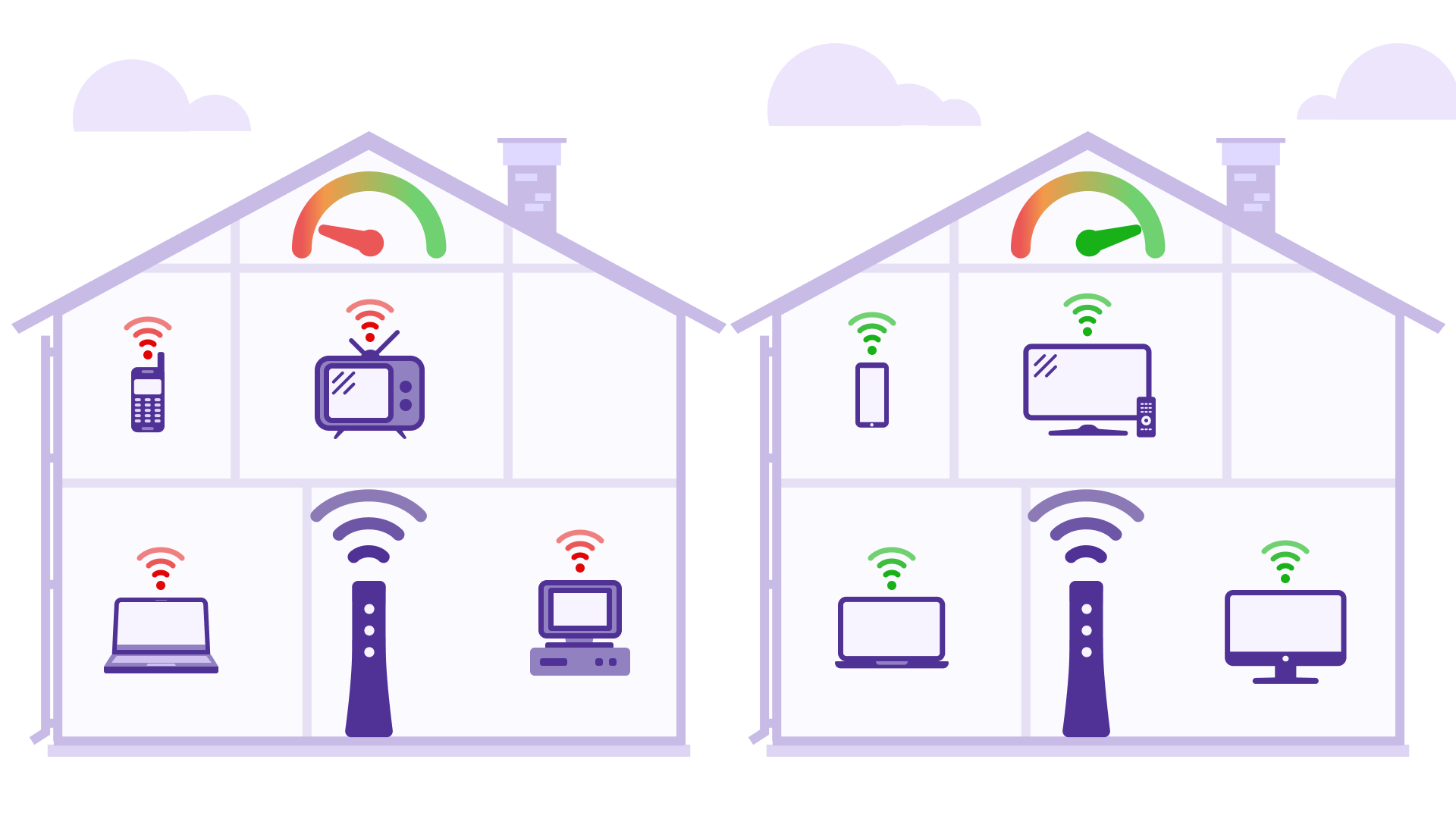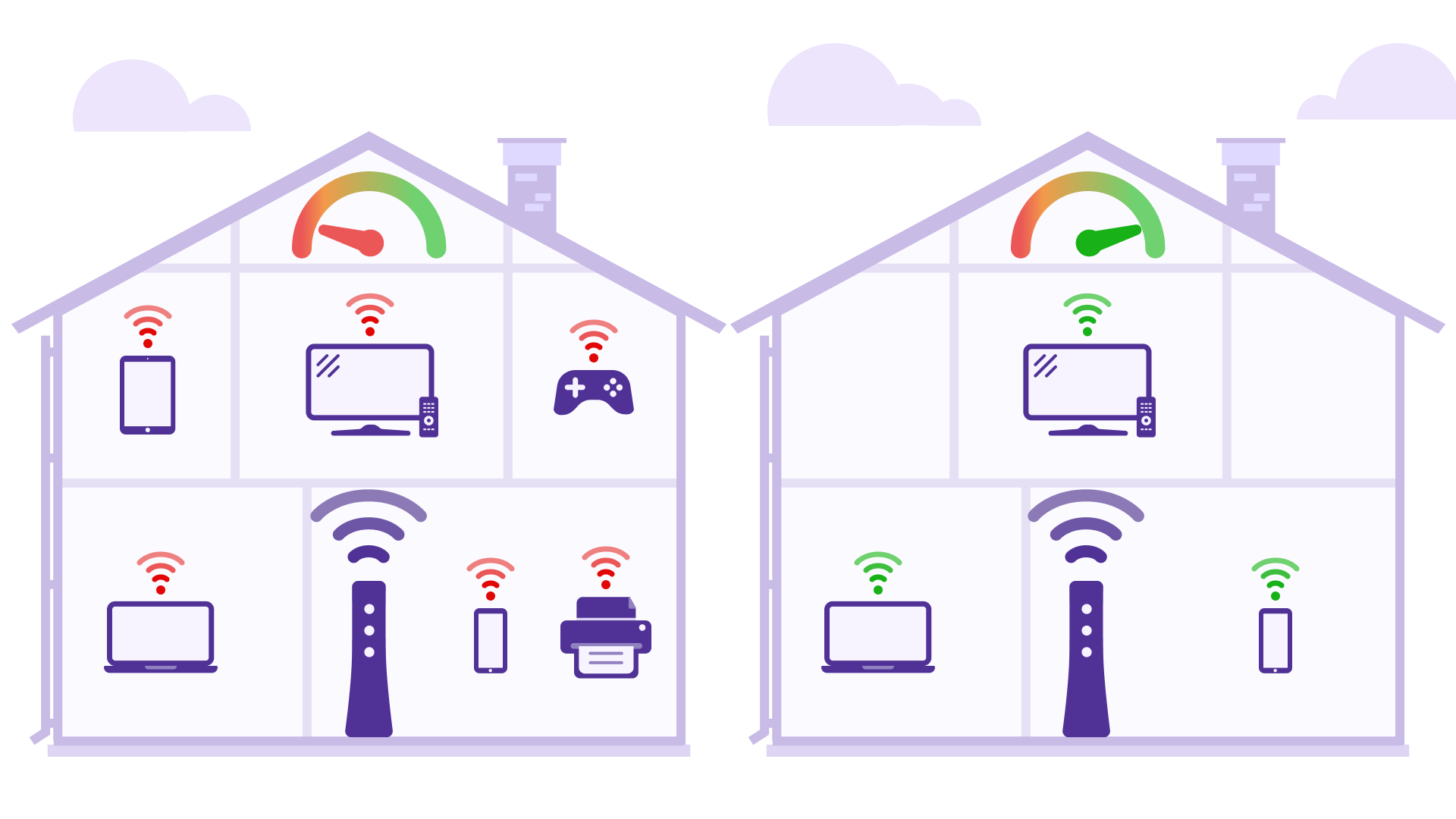Maximizing multi-gig speeds
In select areas, speed plans of 1 Gbps, 3 Gbps, and 8 Gbps are now available. If you’re ready to ride the wave of the future, hop on! But there are a few things you should know. With speeds this fast, any old device won’t cut it. Learn what you need to get your setup multi-gig ready.
Multi-gig speed FAQs
Depending on your location, we offer plans of up to 1 Gbps, 3 Gbps, and 8 Gbps, as measured from the Quantum Fiber network to the SmartNID modem. With incredible numbers like these, the benefits come down to three major factors:
Massive bandwidth. You can connect an unlimited number of bandwidth-hungry devices and run everything at once without seeing slowdowns. And even as you add more smart devices and use more bandwidth in the future, your internet connection won’t suffer.
Ultra-fast speeds. Due to device limitations, you are unlikely to see your plan speed on any one device, but the incredible potential is real. Plans with up to 3 Gbps are measured at 15 times faster than the average U.S. download speed, with 8 Gbps clocking in at 40 times faster. So you can download and upload large files in seconds or minutes, and quickly back up data for every device without stepping on the speed on your other devices.
Low latency. Every video you stream, every multi-player game you play, every videoconference you host, or even several at once—can be used simultaneously without stepping on each other’s performance.
You may hear these two terms used interchangeably, but they refer to different concepts:
- Bandwidth is the maximum amount of data that can be transmitted over an internet connection, measured in Gigabits per second (Gbps), or Megabits per second (Mbps) for lower bandwidth.
- Speed (or throughput) to the device is the rate at which content reaches any one device (tablet, laptop, smartphone, etc.) from the internet at any one time. This is also measured in Gbps or Mbps.
To help you understand the difference, think about a water pipe that supplies water to a whole building. The bandwidth is the diameter of the pipe, which determines how much water can flow through the pipe in a second. The speed equates to how fast that water comes out of the tap when you turn it on. The water speed will vary a lot depending on which faucet you turn on, how far away it is from the main pipe, how many smaller pipes the water has to travel through, and how many faucets are running at once.
Multi-gig plans do get you incredible speeds on all your devices. But the true beauty is the total bandwidth, which allows you to connect as many devices as you want simultaneously, with plenty of bandwidth to spare. And low latency means you never end up with only a trickle of speed to one device due to bandwidth is being gobbled up by all the others.
For the most accurate speed test, we recommend using the Quantum Fiber app. Speed tests run in other tools can be misleading, as they have different testing standards or test from locations that don't give accurate results.
To realize the full capacity of your purchased speed (1 Gbps, 3 Gbps, or 8 Gbps), there are a couple of hardware requirements:
- A wired connection to the modem with a CAT6 or CAT6a Ethernet cable
- A network interface card in the device that can support these speeds
Wired vs. wireless access
First, it's a fact that speeds are affected by using a WiFi connection. Under ideal conditions, our 360 WiFi network is capable of speeds in the range of 1.4 to 1.7 Gbps, though many devices will have max speeds below that. The connection speed over wireless on any given device will vary depending on real-world factors such as device capability, interference, and distance from the WiFi pods.
To realize top multi-gig speed potential, a wired connection is a must. This means physically plugging the device in to the modem or SmartNID. Plug an Ethernet cable into your device and into the 10G LAN port on the bottom of your 6500XK. For best results, use a CAT6 or CAT6a Ethernet cord.
Pro tip: Use a network switch to plug in multiple devices
If you need a wired connection for more than four devices, we recommend purchasing a 10G network switch. This device plugs into the modem with a CAT6 or CAT6a Ethernet cable, and then you can plug several devices into the switch. We recommend one of these:
- TP-Link TL-SX105
- TP-Link TL-SX1008
Network interface cards
Secondly, for any device to achieve multi-gig speeds, it has to have a network interface card with the same speed capability as your plan. A network interface card (or controller) is a piece of computer hardware that connects your device to the internet through a wired Ethernet connection. These come standard with the newest laptops, but if your device was manufactured before 2021, it's likely it doesn't have a network card capable of gig-speeds.
Pro tip: Use a network adapter for faster speeds on older devices
For pre-2021 PCs and laptops, you can buy and install an upgraded network card, or you may need an adapter. We recommend one of these:
- Sonnet Solo 10G 10GBASE-T
- Sabrent Thunderbolt 10G TH-S3EA
- OWC Thunderbolt 3 10G
On some gaming consoles, you might be limited to the built-in 1G network card.
This can be frustrating, but the truth is that with an uber-fast connection, many other factors can get in the way of seeing the speedy responses you expect. There are several factors that can impact download times:
- Content provider networks – Some providers may cap their transfer rate to something less than the multi-gig capability of your own connection, which will put a limit on how fast downloads can go
- WiFi connection vs hardwired connection (see previous question for details)
- Not using a suitable network interface card (see previous question for details)
- Network congestion
There are quite a few factors that impact the real-world speeds you get at any given time on your devices.
Device speed: Every device, including laptops, desktops, tablets, and smart devices such as TVs, phones, appliances, has its own unique processing and hardware capabilities. You’ll see the best performance on devices made in the past two years.

Number of devices: All devices connected to the network share the internet connection. More devices = more sharing. However, bandwidth this massive means that sharing is unlikely to impact device speed.

WiFi use: Wireless connections are limited by signal loss, interference, and the capabilities of the technology itself. The farther away any device is from the WiFi signal, the slower the connection speed will be. Physical barriers like walls, floors and doors can cut speed as well. The 360 WiFi system reduces the impact of these obstacles by placing multiple access points throughout your space.
Other WiFi networks: Business complexes and buildings with multiple units may have multiple wireless signals that interfere with each other.
Website hosts: Website servers use different internet providers to deliver content to you, and those providers may have different capacities. Visiting some sites during peak hours can cause lags or slower responses.
We call it the C6500XK SmartNID. You might think of it like a modem, but it's also a fiber network terminal. Quantum Fiber will provide a state-of-the-art 10 Gbps fiber-enabled device, which will be permanently mounted inside your home or unit. Multi-gig speed plans also include 360 WiFi at no extra cost. This whole home mesh-network eliminates dead-spots and provides consistent and protected WiFi throughout your home or small business.
Nope. When you order a multi-gig plan, technician installation is included at no extra charge. The tech will install your gig-speed modem and get your 360 WiFi network set up and running.
Related topics
Was this information helpful?







